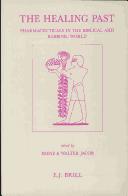| Listing 1 - 3 of 3 |
Sort by
|
Book
ISBN: 1501502530 9781501502538 9781501502552 1501502557 9781501510779 1501510770 1501502549 Year: 2017 Publisher: Boston, Massachusetts ; Berlin, [Germany] : De Gruyter,
Abstract | Keywords | Export | Availability | Bookmark
 Loading...
Loading...Choose an application
- Reference Manager
- EndNote
- RefWorks (Direct export to RefWorks)
With a clear comparative approach, this volume brings together for the first time contributions that cover different periods of the history of ancient pharmacology, from Greek, Byzantine, and Syriac medicine to the Rabbinic-Talmudic medical discourses. This collection opens up new synchronic and diachronic perspectives in the study of the ancient traditions of recipe-books and medical collections. Besides the highly influential Galenic tradition, the contributions will focus on less studied Byzantine and Syriac sources as well as on the Talmudic tradition, which has never been systematically investigated in relation to medicine. This inquiry will highlight the overwhelming mass of information about drugs and remedies, which accumulated over the centuries and was disseminated in a variety of texts belonging to distinct cultural milieus. Through a close analysis of some relevant case studies, this volume will trace some paths of this transmission and transformation of pharmacological knowledge across cultural and linguistic boundaries, by pointing to the variety of disciplines and areas of expertise involved in the process.
Pharmacology --- Medicine, Ancient. --- Medicine, Greek and Roman. --- Medicine in rabbinical literature. --- Diseases in rabbinical literature --- Medicine in the Talmud --- Rabbinical literature --- Greek medicine --- Medicine, Roman --- Medicine, Unani --- Roman medicine --- Tibb (Medicine) --- Unani medicine --- Unani-Tibb (Medicine) --- Medicine, Ancient --- Ancient medicine --- Medicine --- Drug effects --- Medical pharmacology --- Medical sciences --- Chemicals --- Chemotherapy --- Drugs --- Pharmacy --- Physiological effect --- Pharmacologie --- HISTORY / Ancient / General. --- HISTORY / Middle East / Egypt (see also Ancient / Egypt). --- RELIGION / Judaism / History. --- SCIENCE / History. --- Influence juive.

ISBN: 9004096434 9004377328 Year: 1993 Volume: vol 7 Publisher: Leiden ; New York ; Köln E.J. Brill
Abstract | Keywords | Export | Availability | Bookmark
 Loading...
Loading...Choose an application
- Reference Manager
- EndNote
- RefWorks (Direct export to RefWorks)
This volume focuses on our present knowledge of pharmaceuticals in the Biblical and Rabbinic world, a subject which has received little attention. Although many aspects of ancient Near Eastern cultural life have been studied thoroughly, no one has dealt with the pharmaceutical knowledge of this period. The essays in this study deal with their themes in different ways. They thus provide the best current information on a particular subject. They also demonstrate various approaches which may prove fruitful for further investigation. References in specialized studies and archeological field work have demonstrated that our knowledge in this area continues to grow. The fragmented and isolated nature of this material has led to it remaining unknown to those interested in the history of medicine, pharmacy, and horticulture. The authors have sought to fill this gap.
615.89 --- Drugs --- -Medicinal plants --- -Medicine in rabbinical literature --- -Pharmacy --- -Drugs in the bible --- -Chemistry --- Medicine --- Materia medica --- Pharmacology --- Diseases in rabbinical literature --- Medicine in the Talmud --- Rabbinical literature --- Drug plants --- Plants, Useful --- Botanical drug industry --- Botany, Medical --- Materia medica, Vegetable --- Psychotropic plants --- Medicaments --- Medications --- Medicine (Drugs) --- Medicines (Drugs) --- Pharmaceuticals --- Prescription drugs --- Bioactive compounds --- Medical supplies --- Pharmacopoeias --- Chemotherapy --- Pharmacy --- Volksgeneesmiddelen. Kruidentherapie --- History --- -Congresses --- Congresses --- -Volksgeneesmiddelen. Kruidentherapie --- Drugs in the Bible --- Medicinal plants --- Medicine in rabbinical literature --- Chemistry --- History&delete& --- Bible --- Congresses. --- Biblia --- Drugs. --- Drugs in the Bible. --- Medicinal plants. --- Medicine in rabbinical literature. --- Pharmacy. --- Bible. --- Middle East. --- Asia --- Asia, Western --- Eastern Mediterranean --- Eastern Mediterranean Region --- Fertile Crescent --- Levant --- Middle East --- Mideast --- Near East --- South West --- Southwest Asia --- West Asia --- Western Asia
Book
ISBN: 9782848352756 2848352752 Year: 2014 Publisher: Paris : In press,
Abstract | Keywords | Export | Availability | Bookmark
 Loading...
Loading...Choose an application
- Reference Manager
- EndNote
- RefWorks (Direct export to RefWorks)
A. Toledano entend démontrer que le savoir médical dans le Talmud, retranscrit entre l'an 200 et 500 de notre ère, est le précurseur de notre médecine contemporaine, et constate que les règles concernant l'hygiène, la sexualité, les maladies, la nutrition ou l'anatomie sont étonnamment modernes. ©Electre 2014
Medicine --- Médecine --- Religious aspects --- Judaism --- History --- Aspect religieux --- Judaïsme --- Histoire --- Medicine in rabbinical literature --- Medicine, Ancient --- 296*22 --- 61 <09> --- 296*22 Talmud --- Talmud --- Ancient medicine --- Health Workforce --- Diseases in rabbinical literature --- Medicine in the Talmud --- Rabbinical literature --- Religious aspects&delete& --- Geschiedenis van de geneeskunde --- Medecine --- Religious Aspects --- règles d’hygiène alimentaire --- connaissances gynécologiques novatrices --- la grossesse à la naissance de l’enfant --- vie sexuelle --- maladies cardio-vasculaires --- maladies du sang --- maladies digestives --- L’art dentaire --- maladies de la peau --- maladies des reins et de l’appareil uro-génital --- maladies neurologiques --- maladies des yeux --- la spondylarthrite à travers les maux --- maladies infectieuses --- maladies psychiatriques --- démons et sorcières --- tumeurs et cancer --- la mort --- les 63 traités du Talmud --- les grands médecins de l’époque talmudique --- Le Talmud --- la médecine moderne --- Livre des Remèdes --- connaissances anatomiques des médecins du Talmud --- règles d’hygiène corporelle
| Listing 1 - 3 of 3 |
Sort by
|

 Search
Search Feedback
Feedback About UniCat
About UniCat  Help
Help News
News